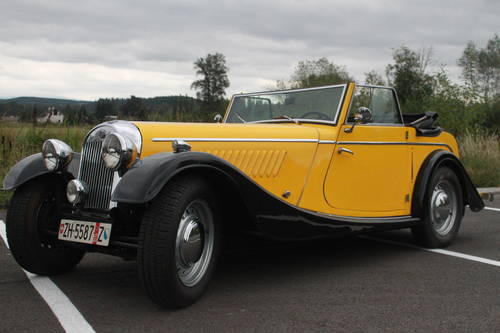Morgans do not just evoke the past, they are the past – come to life to remind us of what once was – and for a price and patience – what can be again. Against all odds, Morgan has outlasted its larger rivals throughout the years from BMC, Standard-Triumph, Rootes and eventually British Leyland; and it has done so with single-family ownership and using a design that has remained fundamentally unchanged since 1936. Well after the world had adopted monocoque construction and mass-production methods, Morgans from Malvern Link still hand formed steel panels on ash-built sub-frames, set upon a separate chassis and hand-assembled by cottage industry craftsman who were raised in the art by their fathers and their own fathers before them. For more than a century, the Morgan family has withstood the temptation to advance, improve and evolve, choosing instead to continue to sell what they have always sold – the most venerable and anachronistic sports car in the world.
![4005761[1]](http://mossmotorsltd.wpengine.com/wp-content/uploads/2015/08/40057611.jpg)
The profile of the early Plus Four DHC is delightfully ‘prewar’ with the dual spare tire mounting an attractive anachronism
![4005765[1]](http://mossmotorsltd.wpengine.com/wp-content/uploads/2015/08/40057651.jpg)
With much less weight than with the contemporary TR, the Plus Four is a better performer in straight line and the twisty bits
Other than engine changes necessitated by supply and performance considerations, there have been few substantive modifications to the basic formula. The cars became faster with better engines and the Plus 4 – which had lost its engine with the arrival of the TR5 and much of its performance advantage over the 4/4 too – was itself replaced in 1968 by the Rover V-8 powered Plus 8. The procession from 4/4, Plus 4 to Plus 8 did not diminish the essence of the marque. Every Morgan model – regardless of engine – shares the same harsh ride, lightning acceleration and Depression-era styling – Thank God for that.
Driven
Also unblemished by the passage of time are the unique dynamic characteristics identified with the cars. In appearance, the Plus 4 resembles the T-Series MG or prewar Riley, Singer and Wolseley, although that resemblance is much stronger in the flat radiator models like the one driven here. The cut-down doors are low and short and ingress is best accomplished by placing one’s feet into the footwell and then sitting down onto the flat seat cushions while rotating the hips. The seats backs and squabs are thinly padded and narrow without much in the way of adjustment. Legroom is not as good as in the TR2 and requires a knees-out attitude to work the pedals and clear the wheel. The driver’s position vis-à-vis the 4-spoke wheel means that the elbows are cast sideways with arms akimbo rather straight out. With exceptionally high steering effort this is not a bad thing. The dash is fashioned out of a single wooden piece and it has a decidedly homemade quality to it but the instruments themselves are jewel-like in design and function and there is an open glovebox located before the passenger.The Vanguard powered Plus 4 is delightfully quick with impressive torque on hand and lively acceleration – weighing as it does 400 pounds less than the TR4 – and corners incredibly using suspension components that were obsolescent before World War II. In fact, several period sources refer to the Morgan’s roadholding as “legendary” and that reputation was achieved in concert with a ride that was unflinchingly stiff, which is surprising for a chassis so flexible.
Rough road surfaces lead to some scuttle shake and there is always some flexion going on around the driver when underway. The steering is quick but the effort to turn the wheel borders on herculean at anything resembling less than high speed. The Moss crash-box requires patience and a firm hand to use properly and it is essential to dutifully double-clutch to ensure smooth operation. The brakes, disc in front from 1960, are effective and powerful, particularly since the Morgan is so light when compared to its 60s peers. Luggage room is dependant on whether one is in a two-seat or four-seat model but there is always adequate space behind the front seats for adequate (if not secure) storage. All told, the Morgan feels like the fastest T-Series in the world – with a surfeit of horsepower and torque – with handling that is nigh competition ready. Writing in 1966, Automobile Quarterly opined that “Morgans are sheer fun to drive, and they produce more amusement than a trainload of Playboy bunnies. I kid you not.” Like the cars themselves, nothing has really changed since.
Sampled – The 1951 Morgan Plus Four DHC driven here was supplied by Chequered Flag International in Marina Del Rey, California. A former AACA (1978) National first place winner, it has been driven down into very good driver condition with only a few paint blemished spoiling the unique yellow and black livery. The interior displays a wonderful patina and the performance provided by the Standard sourced engine is beyond reproach. The steering was excellent – likely due to recent work from Isis Imports – and the ride was exactly what one would expect from a vintage Morgan (something like a TR3 on steroids).





![4005763[1]](http://mossmotorsltd.wpengine.com/wp-content/uploads/2015/08/40057631.jpg)





'Driven – 1951 Morgan Plus Four DHC' has no comments
Be the first to comment this post!